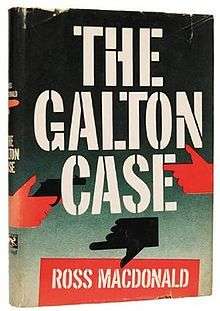The Galton Case

The Galton Case is the eighth book in the Lew Archer Series by Ross Macdonald. It was published in 1959. Macdonald thought with this book he found his own voice as a writer.[1]
Blurb
From the back of the 1983 Bantam edition:
Rich boy Anthony Galton had dropped out of sight more than twenty years ago. To Lew Archer that meant the man was either dead or didn't want to be found. But Tony's nice old mother had a dream that her son would still come home before she died. So Archer took on the case hoping that Tony and Mom could live happily ever after... until he discovered that once upon a time there was a clever swindle, a scared blonde, and a very nasty murder.[2]
Influence
The book influenced the American writer Jerome Charyn to begin his detective series "The Isaac Quartet", beginning with the novel Blue Eyes published in 1974.[3] Wrote Charyn: "The book had a morphology I happened to admire - as if Ross Macdonald were in the habit of undressing bodies to find the skeleton underneath. Nothing was overwrought: landscape, language, and character were all laid bare. But this was no simpleminded accident. It was Macdonald’s particular craft, that “wild masonry of laying detail on detail to a make a structure.”[4]
References
- ↑ "I was forty-two when I wrote The Galton Case. It had taken me a dozen years and as many books to learn how to tell highly personal stories in terms of the convention I had chosen." Macdonald, Ross (1973). On Crime Fiction. Santa Barbara : Capra Press, Series title: Yes! Capra chapbook series ; no. 11, p. 27
- ↑ From the back of the 1983 Bantam edition
- ↑ "Master of Mythologies 3: The Isaac Quartet"
- ↑ Jerome Charyn, "Blue Eyes and the Barber King", quoted by Alex Waterhouse on his blog entry, "Glock - Verb, Transitive ", January 12, 2011. Charyn quotes Ross Macdonald's own essay about the novel: "Writing the Galton Case," which appears in Self-Portrait: Ceaselessly Into the Past. Santa Barbara: Capra Press, 1981